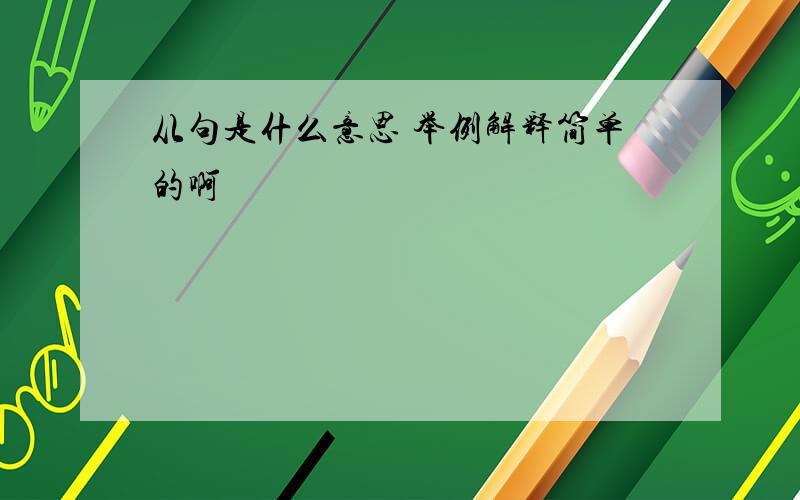从句是什么意思 举例解释简单的啊
来源:学生作业帮助网 编辑:作业帮 时间:2024/04/28 06:43:09

从句是什么意思 举例解释简单的啊
从句是什么意思 举例解释
简单的啊
从句是什么意思 举例解释简单的啊
从句不能单独成句,但它也有主语部分和谓语部分,就像一个句子一样.所不同在于,从句须由一个关联词(connective)引导. 根据引导从句为主不同大概可分为:主语从句、表语从句、宾语从句、同位语从句、定语从句和状语从句6类.前四类由于主语从句、表语从句、宾语从句及同位语从句在句子的功用相当于名词,所以通称名词性从句;定语从句功能相当于形容词,称为形容词性从句;而状语从句功能相当于副词,称为副词性从句.状语从句还可以分为条件状语从句、原因状语从句、地点状语从句和时间状语从句. 1.主语从句(Subject Clause):用作主语的从句叫主语从句.引导主语从句的关联词有从属连词、疑问代词、疑问副词、缩合连接代词、缩合连接副词等. 2.表语从句(Predicative Clause):用作表语的从句叫表语从句.引导表语从句的关联词与引导主语从句的关联词大都一样. 3.宾语从句(Object Clause):在句子中起宾语作用的从句叫做宾语从句.宾语从句分为三类:动词的宾语从句,介词的宾语从句和形容词的宾语从句. 4. 同位语从句是名词性从句(主语从句、表语从句、宾语从句、同位语从句)中的主要从句之一,从句作同位语表示与之同位的名词(短语)的实际内容,它的作用相当于名词,对前面的名词(短语)加以补充说明或进一步解释,相当于一个表语从句,它们之间的关系是同位关系,即主表关系. 5.定语从句是由关系代词或关系副词引导的从句,其作用是作定语修饰主句的某个名词性成分,相当于形容词,所以又称为形容词性从句,一般紧跟在它所修饰的先行词后面. 6.状语从句可分为: (1)时间状语从句:(adverbial clause of time) (2)地点状语从句:(adverbial clause of place) (3)原因状语从句:(adverbial clause of cause) (4)条件状语从句:(adverbial clause of condition) (5)目的状语从句:(adverbial clause of purpose) (6)让步状语从句:(adverbial clause of concession) (7)比较状语从句:(adverbial clause of comparison) (8)方式状语从句:(adverbial clause of manner) (9)结果状语从句:(adverbial clause of result) 7.德语中的从句:状语从句和宾语从句均用 Dass 来引导
编辑本段宾语从句
定义
宾语从句就是一个句子作动词或介词的宾语.
三要素
连接词、语序和时态. 连接词一般都是that(指事物或人),which(指事),who(指人) 1.从句为陈述句,常选择连接词that或将that省略,直接与主句相连. 2.从句为一般疑问句,常选择连接词if或whether.在whether…or not结构中不能用if替换. 3.从句为特殊疑问句,常选择what,when,where,which,who,how等的疑问代、副词作连接词. ★当who为主语时,句式为:who+谓语+其他 判断时态情况: 1.主句是一般现在时,从句为各种时态情况 2.主句是一般过去时,从句为各种相应过去时态.注意:从句描绘客观事实,用一般现在时 3.主句是一般将来时,一般从句为一般现在时(“主将从现”) 例题: (1. The teacher told the children that the sun____ round. A. was B. is C. were D. are 选B,因其陈述为无可争议的客观事实 (2. I believe that our team____ the basketball match. A. win B. won C. will win D. wins 选C ,这是讲话人现在对将来情况的主观推测 (3.The soldiers soon reached( )was once an old temple( )the villagers used as a school. A.which;where B.what;which C.where;which D.what;where 答3:选B,动词reach后接宾语从句,从句缺少宾语,where不可,which引导宾语从句时表疑问含义“哪一个…”而此句中并非疑问含义,不知道哪一座庙宇,而是用what从句表陈述含义,意“过去的一座旧庙宇”;te-mple后为对其修饰的定语从句,用关系代词which代替,并在从句中作动词used的宾语,use sth. as…“把…用作… 宾语从句,在复合句中作宾语,位于及物动词后; Tell him which class you are in . Do you know what he likes? (1)主、从句时态一致: 主句谓语过去时,从句相应过去时; He answered that he was listening to me. 主句谓语现在时,从句时态任所需; He says (that) he will leave a message on my desk. They know (that) he is working hard. 具体过去永不变,真理格言现在时; He told me that he was born in 1980. Father told me that practice makes perfect . (2)否定前移,及完成反意问句; 在think / believe / suppose / guess / imagine / expect等动词后跟宾语从句否定式时,应转移到主句上去,完成反意疑问句时,应与从句主、谓保持一致.(注: 否定前移的条件是,主句主语是第一人称) I don't think you are right ,are you ? I don't believe they have finished their work yet,have they ? (3)在表示建议suggest , advise 要求demand 、desire、require、request、propose; 决定 decide; 命令 order、command; 坚决主张 insist; 等动词后跟宾语从句,用(should)+v.(虚拟语气) eg. I suggested that you(should)study hard. He ordered that we should go out at once. (4)如果宾语从句后有宾语补足语,用it作形式宾语,把宾语从句后置 eg.You may think it strange that he would live there. (5)宾语从句that常可省略,但在以下情况下不能省略 A.当主句谓语动词带有两个或两个以上宾语从句时,可以省略第一个that,其他不能省略. eg.I believe(that)you have done your best and that things will get best? B.当it作形式宾语时 eg.She made it clear that she had nothing to do with him. C.当宾语从句前置时 eg.That our team will win,I believe.
分类
A 、作动词的宾语: eg.I heard the news I 主语 heard 谓语动词 the news.名词作宾语 I主语 heard 谓语动词 that he would come here later on.一个句子作宾语---宾语从句 B 、作介词的宾语: eg.He said nothing about this plan . He主语 said 谓语动词 nothing 代词作动词的宾语 about 介词 the plan. 名词作介词的宾语
带有宾语从句的复合句的构成
带有宾语从句的复合句就是用连接词把一个主句和一个宾语从句连接在一起.连接词有:that(可省略),what, who, when, where, why, which, if, whether, how.
注意
A 宾语从句必须用陈述语序. False: He is wondering when can he finish this difficult job. Right: He is wondering when he can finish this difficult job. B 有时候可以用it 作形式宾语,而把真正的宾语从句放在后面. Bad: I thought that he could finish this job in just two hours impossible. Good: I thought it impossible that he could finish this job in just two hours. Bad: He left whether we should continue this project to my judgment. Good: He left it to my judgment whether we should continue this project. C 带有宾语从句的复合句的否定形式一般是否定主句. Bad: I think he doesn’t like the English teacher. Good: I don’t think he likes the English teacher. D False: He wanted to know why he is crying in the corner. Right: He wanted to know why he was crying in the corner. 4.同位语从句(Appositive Clause): 与先行词同位或等同的从句叫作同位语从句.其关联词多为that. 5.定语从句(Attributive Clause):用作定语的从句叫定语从句.定语从句一般皆放在被它所修饰的名(代)词之后,这种名(代)词就叫作先行词(Antecedent).引导定语从句的关联词为关系代词(或称引导词、关系词等).关系代词在定语从句中可用作主语、宾语、定语等;关系副词在定语从句中用作状语. ①引导定语从句的关联词有who, whom, whose, that, when, where, why 和 which. 在非限制定语从句中, 只可用which, who, whose, where , when., 如果指代前面整个句子, 多用which. 例句: The dog that/which was lost has been found. (失踪的狗已经找到了.) Those who are in favor of the proposal are expected to discuss it in detail after the meeting. (有人认为那些对这个提案有兴趣的人最好是在会后再具体讨论它.) There are many organizations whose purpose is to help the homeless. (存在着许多旨在帮助无家可归者的组织.) The days when we had to rely on wool, cotton or silk for our clothes have now passed. (那种必须依赖羊毛,棉花或者蚕丝做衣服的日子已经过去了.) Air moves from places where the pressure was high to places where the pressure is low. (空气从压强高的地方流向压强低的地方.) This is the reason why he refused to help us. (这就是他拒绝帮助我们的原因.)